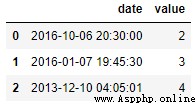When we are sorting out the data , Data type errors often occur , Today, I'd like to share with you about Pandas Module in the data type conversion related skills , It's full of dry goods !
So our first routine is to import Pandas Module and create data set , The code is as follows
import pandas as pd
import numpy as np
df = pd.DataFrame({
'string_col': ['1','2','3','4'],
'int_col': [1,2,3,4],
'float_col': [1.1,1.2,1.3,4.7],
'mix_col': ['a', 2, 3, 4],
'missing_col': [1.0, 2, 3, np.nan],
'money_col': ['£1,000.00', '£2,400.00', '£2,400.00', '£2,400.00'],
'boolean_col': [True, False, True, True],
'custom': ['Y', 'Y', 'N', 'N']
})
dfoutput

Let's first look at the data types of each column , The code is as follows
df.dtypesoutput
string_col object
int_col int64
float_col float64
mix_col object
missing_col float64
money_col object
boolean_col bool
custom object
dtype: objectOf course, we can also call info() Method to achieve the above purpose , The code is as follows
df.info()output
<class 'pandas.core.frame.DataFrame'>
RangeIndex: 4 entries, 0 to 3
Data columns (total 8 columns):
# Column Non-Null Count Dtype
--- ------ -------------- -----
0 string_col 4 non-null object
1 int_col 4 non-null int64
2 float_col 4 non-null float64
3 mix_col 4 non-null object
4 missing_col 3 non-null float64
5 money_col 4 non-null object
6 boolean_col 4 non-null bool
7 custom 4 non-null object
dtypes: bool(1), float64(2), int64(1), object(4)
memory usage: 356.0+ bytes Next, we start the data type conversion , The most commonly used is astype() Method , For example, we convert floating-point data to integer , The code is as follows
df['float_col'] = df['float_col'].astype('int')Or we'll take one of them “string_col” This column is converted to integer data , The code is as follows
df['string_col'] = df['string_col'].astype('int') Of course, we consider from the perspective of saving memory , convert to int32 perhaps int16 Data of type ,
df['string_col'] = df['string_col'].astype('int8')
df['string_col'] = df['string_col'].astype('int16')
df['string_col'] = df['string_col'].astype('int32')Then let's take a look at the data types of each column after conversion
df.dtypesoutput
string_col float32
int_col int64
float_col int32
mix_col object
missing_col float64
money_col object
boolean_col bool
custom object
dtype: objectBut when a column has more than one data type , An error will be reported during the conversion process , for example “mix_col” This column
df['mix_col'] = df['mix_col'].astype('int')output
ValueError: invalid literal for int() with base 10: 'a' So we can call to_numeric() Methods and errors Parameters , The code is as follows
df['mix_col'] = pd.to_numeric(df['mix_col'], errors='coerce')
dfoutput

And if you encounter missing values , An error will also occur during data type conversion , The code is as follows
df['missing_col'].astype('int')output
ValueError: Cannot convert non-finite values (NA or inf) to integerWe can start by calling fillna() Method to populate missing values with other values , And then type conversion , The code is as follows
df["missing_col"] = df["missing_col"].fillna(0).astype('int')
dfoutput

And finally “money_col” This column , We can see the currency symbol in it , So the first step we have to do is to replace these currency symbols , Then the data type is converted , The code is as follows
df['money_replace'] = df['money_col'].str.replace('£', '').str.replace(',','')
df['money_replace'] = pd.to_numeric(df['money_replace'])
df['money_replace']output
0 1000.0
1 2400.0
2 2400.0
3 2400.0 When we need to type convert data in date format , What you usually need to call is to_datetime() Method , The code is as follows
df = pd.DataFrame({'date': ['3/10/2015', '3/11/2015', '3/12/2015'],
'value': [2, 3, 4]})
dfoutput

Let's first look at the data types of each column
df.dtypesoutput
date object
value int64
dtype: object We call to_datetime() The code of the method is as follows
pd.to_datetime(df['date'])output
0 2015-03-10
1 2015-03-11
2 2015-03-12
Name: date, dtype: datetime64[ns] Of course, this does not mean that you cannot call astype() The method , The result is the same as the above , The code is as follows
df['date'].astype('datetime64') When we encounter date format data in user-defined format , Also call to_datetime() Method , But the format that needs to be set is format Parameters need to be consistent
df = pd.DataFrame({'date': ['2016-6-10 20:30:0',
'2016-7-1 19:45:30',
'2013-10-12 4:5:1'],
'value': [2, 3, 4]})
df['date'] = pd.to_datetime(df['date'], format="%Y-%d-%m %H:%M:%S")output

Last , Maybe someone will ask , Is there any way to realize data type conversion in one step ? That, of course, can be achieved , The code is as follows
df = pd.DataFrame({'date_start': ['3/10/2000', '3/11/2000', '3/12/2000'],
'date_end': ['3/11/2000', '3/12/2000', '3/13/2000'],
'string_col': ['1','2','3'],
'float_col': [1.1,1.2,1.3],
'value': [2, 3, 4]})
df = df.astype({
'date_start': 'datetime64',
'date_end': 'datetime64',
'string_col': 'int32',
'float_col': 'int64',
'value': 'float32',
})Let's take a look at the results
dfoutput

NO.1
Previous recommendation
Historical articles
Python Eight schemes to realize timed tasks , Dry cargo is full.
use Python among Plotly.Express The module draws several charts , I was really amazed !!
20 A beautiful large visual screen template , The data of various industries are directly applied ( Including source code )
use Python Make visualizations GUI Interface , Turn avatar into animation style with one click !
Share 、 Collection 、 give the thumbs-up 、 I'm looking at the arrangement ?



